Reusing Ceramic Waste as a Fine Aggregate and Supplemental Cementitious Material in the Manufacture of Sustainable Concrete
Abstract
:1. Introduction
2. Experimental Program
2.1. Materials
2.2. Composition of Concrete Mixes
2.3. Testing of Fresh Concrete
2.4. Testing of Hardened Concrete
2.4.1. Compressive Strength
2.4.2. Flexural Strength
2.4.3. Water Penetration
2.4.4. Elevated Temperatures
2.4.5. Microstructure
3. Results and Discussion
3.1. Slump
3.2. Compressive Strength
3.3. Flexural Strength
3.4. Water Penetration
3.5. Elevated Temperature
3.6. Concrete Microstructure
4. Conclusions
- The increase in the replacement levels of CWP and CWF as partial replacements for natural fine aggregate and cement, respectively, decreases the slump value of concrete mixtures.
- The mechanical performance of concrete mixtures, systematically enhanced by the incorporation of ceramic waste under compression and flexural tests as the replacement ratio of CWF, increases up to 50% with the use of 10% CWP instead of cement. The mixture composed of 360 kg/m3 cement, 40 kg/m3 CWP, 358 kg/m3 sand, 358 kg/m3 CWF, 1072 kg/m3 dolomite, 180 kg/m3 water, and 6 kg/m3 superplasticizer achieved its maximum compressive strengths at ages 28 and 90 days, and the strengths were 44.2 and 48.7 MPa, respectively.
- The use of 25% and 50% CWF as a partial substitute for sand enhanced flexural strength by 3.39% and 4.24%, respectively, whereas the replacement ratios of 75% and 100% reduced the flexural strength by 9.66% and 22%, respectively. The optimum value of concrete flexural strength (6.38 MPa) was achieved with the use of 10% CWP as a replacement for cement along with 50% CWF as a replacement for sand.
- The water permeability of concrete significantly increases with the increase in CWF replacement ratio. The average water penetration depth increases by 9.6%, 21.2%, 32.7%, and 57.7% in concrete specimens containing 25%, 50%, 75%, and 100% CWF, respectively, compared to the control mixture, and the incorporation of CWP reduces this negative impact.
- The values of residual and relative compressive strength of concrete specimens containing CWF and CWP and exposed to elevated temperatures increased with the increases in CWF and CWP content. The residual compressive strength was up to 95.02%, 89.66%, 74.33%, and 51.34% after exposure to 200, 400, 600, and 800 °C temperatures, respectively, compared to the control mixture which achieved 84.25%, 76.03%, 59.36%, and 35.84% of its initial strength.
- Microstructure analysis revealed that increasing the CWP concentration has a deleterious influence on the formation of C-(A)-S-H gels, resulting in more non-reacted and partly reacted particles, and combining CWP and CWF significantly improves cement hydration when compared to the reference mixture.
Author Contributions
Funding
Data Availability Statement
Conflicts of Interest
References
- Elemam, W.E.; Abdelraheem, A.H.; Mahdy, M.G.; Tahwia, A.M. Optimizing fresh properties and compressive strength of self-consolidating concrete. Constr. Build. Mater. 2020, 249, 118781. [Google Scholar] [CrossRef]
- Alsaif, A. Utilization of ceramic waste as partially cement substitute–A review. Constr. Build. Mater. 2021, 300, 124009. [Google Scholar] [CrossRef]
- Agwa, I.S.; Omar, O.M.; Tayeh, B.A.; Abdelsalam, B.A. Effects of using rice straw and cotton stalk ashes on the properties of lightweight self-compacting concrete. Constr. Build. Mater. 2020, 235, 117541. [Google Scholar] [CrossRef]
- Tahwia, A.M.; Hamido, M.A.; Elemam, W.E. Using mixture design method for developing and optimizing eco-friendly ultra-high performance concrete characteristics. Case Stud. Constr. Mater. 2023, 18, e01807. [Google Scholar] [CrossRef]
- Jackiewicz-Rek, W.; Załęgowski, K.; Garbacz, A.; Bissonnette, B. Properties of cement mortars modified with ceramic waste fillers. Procedia Eng. 2015, 108, 681–687. [Google Scholar] [CrossRef]
- Abdellatief, M.; Al-Tam, S.M.; Elemam, W.E.; Alanazi, H.; Elgendy, G.M.; Tahwia, A.M. Development of ultra-high-performance concrete with low environmental impact integrated with metakaolin and industrial wastes. Case Stud. Constr. Mater. 2023, 18, e01724. [Google Scholar] [CrossRef]
- Kannan, D.M.; Aboubakr, S.H.; El-Dieb, A.S.; Reda Taha, M.M. High performance concrete incorporating ceramic waste powder as large partial replacement of Portland cement. Constr. Build. Mater. 2017, 144, 35–41. [Google Scholar] [CrossRef]
- Gautam, L.; Jain, J.K.; Kalla, P.; Choudhary, S. A review on the utilization of ceramic waste in sustainable construction products. Mater. Today Proc. 2020, 43, 1884–1891. [Google Scholar] [CrossRef]
- Abdellatief, M.; Elemam, W.E.; Alanazi, H.; Tahwia, A.M. Production and optimization of sustainable cement brick incorporating clay brick wastes using response surface method. Ceram. Int. 2023, 49, 9395–9411. [Google Scholar] [CrossRef]
- Almeshal, I.; Tayeh, B.A.; Alyousef, R.; Alabduljabbar, H.; Mohamed, A.M. Eco-friendly concrete containing recycled plastic as partial replacement for sand. J. Mater. Res. Technol. 2020, 9, 4631–4643. [Google Scholar] [CrossRef]
- Li, L.; Zhuo, Z.; Zhu, J.; Chen, J.; Kwan, A. Reutilizing ceramic polishing waste as powder filler in mortar to reduce cement content by 33% and increase strength by 85%. Powder Technol. 2019, 355, 119–126. [Google Scholar] [CrossRef]
- de Brito, J.; Pereira, A.S.; Correia, J.R. Mechanical behaviour of non-structural concrete made with recycled ceramic aggregates. Cem. Concr. Compos. 2005, 27, 429–433. [Google Scholar] [CrossRef]
- Tikul, N.; Srichandr, P. Assessing the environmental impact of ceramic tile production in Thailand. J. Ceram. Soc. Jpn. 2010, 118, 887–894. [Google Scholar] [CrossRef]
- López, V.; Llamas, B.; Juan, A.; Morán, J.M.; Guerra, I. Eco-efficient Concretes: Impact of the Use of White Ceramic Powder on the Mechanical Properties of Concrete. Biosyst. Eng. 2007, 96, 559–564. [Google Scholar] [CrossRef]
- Steiner, L.R.; Bernardin, A.M.; Pelisser, F. Effectiveness of ceramic tile polishing residues as supplementary cementitious materials for cement mortars. Sustain. Mater. Technol. 2015, 4, 30–35. [Google Scholar] [CrossRef]
- Heidari, A.; Tavakoli, D. A study of the mechanical properties of ground ceramic powder concrete incorporating nano-SiO2 particles. Constr. Build. Mater. 2013, 38, 255–264. [Google Scholar] [CrossRef]
- Reiterman, P.; Holčapek, O.; Čáchová, M.; Vogel, F.; Jogl, M.; Konvalinka, P. Basic and hygric properties of concrete containing fine ceramic powder. Adv. Mater. Res. 2014, 897, 188–191. [Google Scholar] [CrossRef]
- Cheng, Y.-H.; Huang, F.; Liu, R.; Hou, J.-L.; Li, G.-L. Test research on effects of waste ceramic polishing powder on the permeability resistance of concrete. Mater. Struct. 2015, 49, 729–738. [Google Scholar] [CrossRef]
- Vejmelková, E.; Keppert, M.; Rovnaníková, P.; Ondráček, M.; Keršner, Z.; Černý, R. Properties of high performance concrete containing fine-ground ceramics as supplementary cementitious material. Cem. Concr. Compos. 2012, 34, 55–61. [Google Scholar] [CrossRef]
- Awoyera, P.O.; Ndambuki, J.M.; Akinmusuru, J.O.; Omole, D.O. Characterization of ceramic waste aggregate concrete. HBRC J. 2018, 14, 282–287. [Google Scholar] [CrossRef]
- Gonzalez-Corominas, A.; Etxeberria, M. Properties of high performance concrete made with recycled fine ceramic and coarse mixed aggregates. Constr. Build. Mater. 2014, 68, 618–626. [Google Scholar] [CrossRef]
- Zareei, S.A.; Ameri, F.; Bahrami, N.; Shoaei, P.; Musaeei, H.R.; Nurian, F. Green high strength concrete containing recycled waste ceramic aggregates and waste carpet fibers: Mechanical, durability, and microstructural properties. J. Build. Eng. 2019, 26, 100914. [Google Scholar] [CrossRef]
- Medina, C.; de Rojas, M.I.S.; Thomas, C.; Polanco, J.A.; Frías, M. Durability of recycled concrete made with recycled ceramic sanitary ware aggregate. Inter-indicator relationships. Constr. Build. Mater. 2016, 105, 480–486. [Google Scholar] [CrossRef]
- Nepomuceno, M.C.; Isidoro, R.A.; Catarino, J.P. Mechanical performance evaluation of concrete made with recycled ceramic coarse aggregates from industrial brick waste. Constr. Build. Mater. 2018, 165, 284–294. [Google Scholar] [CrossRef]
- Baroghel-Bouny, V.; Kinomura, K.; Thiery, M.; Moscardelli, S. Easy assessment of durability indicators for service life prediction or quality control of concretes with high volumes of supplementary cementitious materials. Cem. Concr. Compos. 2011, 33, 832–847. [Google Scholar] [CrossRef]
- Soldado, E.; Antunes, A.; Costa, H.; Carmo, R.D.; Júlio, E. Durability of mortar matrices of low-cement concrete with specific additions. Constr. Build. Mater. 2021, 309, 125060. [Google Scholar] [CrossRef]
- Siddique, S.; Shrivastava, S.; Chaudhary, S. Durability properties of bone china ceramic fine aggregate concrete. Constr. Build. Mater. 2018, 173, 323–331. [Google Scholar] [CrossRef]
- Kodur, V. Properties of concrete at elevated temperatures. ISRN Civ. Eng. 2014, 2014, 1–15. [Google Scholar] [CrossRef]
- Huseien, G.F.; Sam, A.R.M.; Mirza, J.; Tahir, M.M.; Asaad, M.A.; Ismail, M.; Shah, K.W. Waste ceramic powder incorporated alkali activated mortars exposed to elevated Temperatures: Performance evaluation. Constr. Build. Mater. 2018, 187, 307–317. [Google Scholar] [CrossRef]
- Novak, J.; Kohoutkova, A. Mechanical properties of concrete composites subject to elevated temperature. Fire Saf. J. 2018, 95, 66–76. [Google Scholar] [CrossRef]
- Rashad, A.M.; Essa, G.M. Effect of ceramic waste powder on alkali-activated slag pastes cured in hot weather after exposure to elevated temperature. Cem. Concr. Compos. 2020, 111, 103617. [Google Scholar] [CrossRef]
- Mohit, M.; Sharifi, Y. Thermal and microstructure properties of cement mortar containing ceramic waste powder as alternative cementitious materials. Constr. Build. Mater. 2019, 223, 643–656. [Google Scholar] [CrossRef]
- ES 4756–1; Egyptian Standard Specification for Composition, Specifications and Conformity Criteria for Common Cements. EOS: Cairo, Egypt, 2013.
- BS EN 197–1; Cement–Part 1, Composition, specifications and conformity criteria for common cements. CEN: London, UK, 2011.
- BS EN 12620; Aggregate for Concrete. BSI: London, UK, 2002.
- ASTM C494; Standard Specification for Chemical Admixtures for Concrete. ASTM: West Conshohocken, PA, USA, 2005.
- ASTM C143; Slump of Hydraulic Cement Concrete. Annual Book of ASTM Standards. ASTM: West Conshohocken, PA, USA, 2004.
- BS EN 12390-3; Testing Hardened Concrete. Part 3: Compressive Strength of Test Specimens. BSI: London, UK, 2009.
- ASTM-C78-16; Standard Test Method for Flexural Strength of Concrete (Using Simple Beam with Third-Point Loading). ASTM: West Conshohocken, PA, USA, 2016; Volume 100.
- BS EN 12390-8; Testing Hardened Concrete, Part 8: Depth of Penetration of Water under Pressure. BSI: London, UK, 2009.
- Pachta, V.; Konopisi, S.; Stefanidou, M. The influence of brick dust and crushed brick on the properties of lime-based mortars exposed at elevated temperatures. Constr. Build. Mater. 2021, 296, 123743. [Google Scholar] [CrossRef]
- Huseien, G.F.; Sam, A.R.M.; Shah, K.W.; Mirza, J. Effects of ceramic tile powder waste on properties of self-compacted alkali-activated concrete. Constr. Build. Mater. 2020, 236, 117574. [Google Scholar] [CrossRef]
- Jiménez, J.R.; Ayuso, J.; López, M.; Fernández, J.M.; De Brito, J.M.C.L. Use of fine recycled aggregates from ceramic waste in masonry mortar manufacturing. Constr. Build. Mater. 2013, 40, 679–690. [Google Scholar] [CrossRef]
- Debieb, F.; Kenai, S. The use of coarse and fine crushed bricks as aggregate in concrete. Constr. Build. Mater. 2008, 22, 886–893. [Google Scholar] [CrossRef]
- El-Dieb, A.S.; Kanaan, D.M. Ceramic waste powder an alternative cement replacement–Characterization and evaluation. Sustain. Mater. Technol. 2018, 17, e00063. [Google Scholar] [CrossRef]
- Hilal, N.N.; Mohammed, A.S.; Ali, T.K.M. Properties of Eco-Friendly Concrete Contained Limestone and Ceramic Tiles Waste Exposed To High Temperature. Arab. J. Sci. Eng. 2020, 45, 4387–4404. [Google Scholar] [CrossRef]
- Pachta, V.; Anastasiou, E.K. Utilization of Industrial Byproducts for Enhancing the Properties of Cement Mortars at Elevated Temperatures. Sustainability 2021, 13, 12104. [Google Scholar] [CrossRef]
- Fernandes, B.; Carré, H.; Mindeguia, J.-C.; Perlot, C.; La Borderie, C. Effect of elevated temperatures on concrete made with recycled concrete aggregates—An overview. J. Build. Eng. 2021, 44, 103235. [Google Scholar] [CrossRef]
- Pimienta, P.; Alonso, M.C.; McNamee, R.J.; Mindeguia, J.-C. Behaviour of high-performance concrete at high temperatures: Some highlights. RILEM Tech. Lett. 2017, 2, 45–52. [Google Scholar] [CrossRef]
- Hertz, K.D. Concrete strength for fire safety design. Mag. Concr. Res. 2005, 57, 445–453. [Google Scholar] [CrossRef]
- Canbaz, M. The effect of High temperature on concrete with waste ceramic aggregate. Iran. J. Sci. Technol. Trans. Civ. Eng. 2016, 40, 41–48. [Google Scholar] [CrossRef]
- Zega, C.J.; Di Maio, A.A. Recycled concrete made with different natural coarse aggregates exposed to high temperature. Constr. Build. Mater. 2009, 23, 2047–2052. [Google Scholar] [CrossRef]
- Kou, S.C.; Poon, C.S.; Etxeberria, M. Residue strength, water absorption and pore size distributions of recycled aggregate concrete after exposure to elevated temperatures. Cem. Concr. Compos. 2014, 53, 73–82. [Google Scholar] [CrossRef]


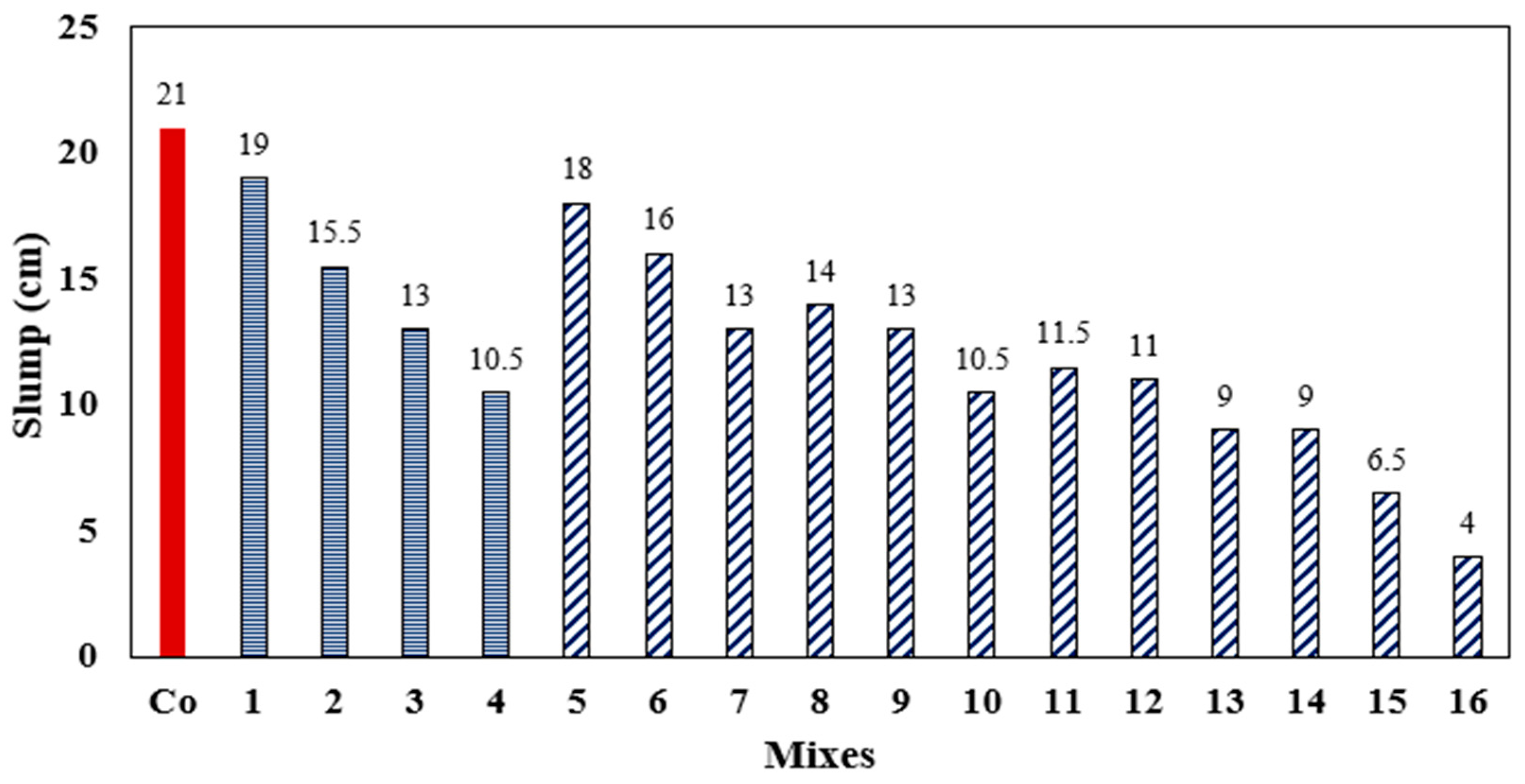
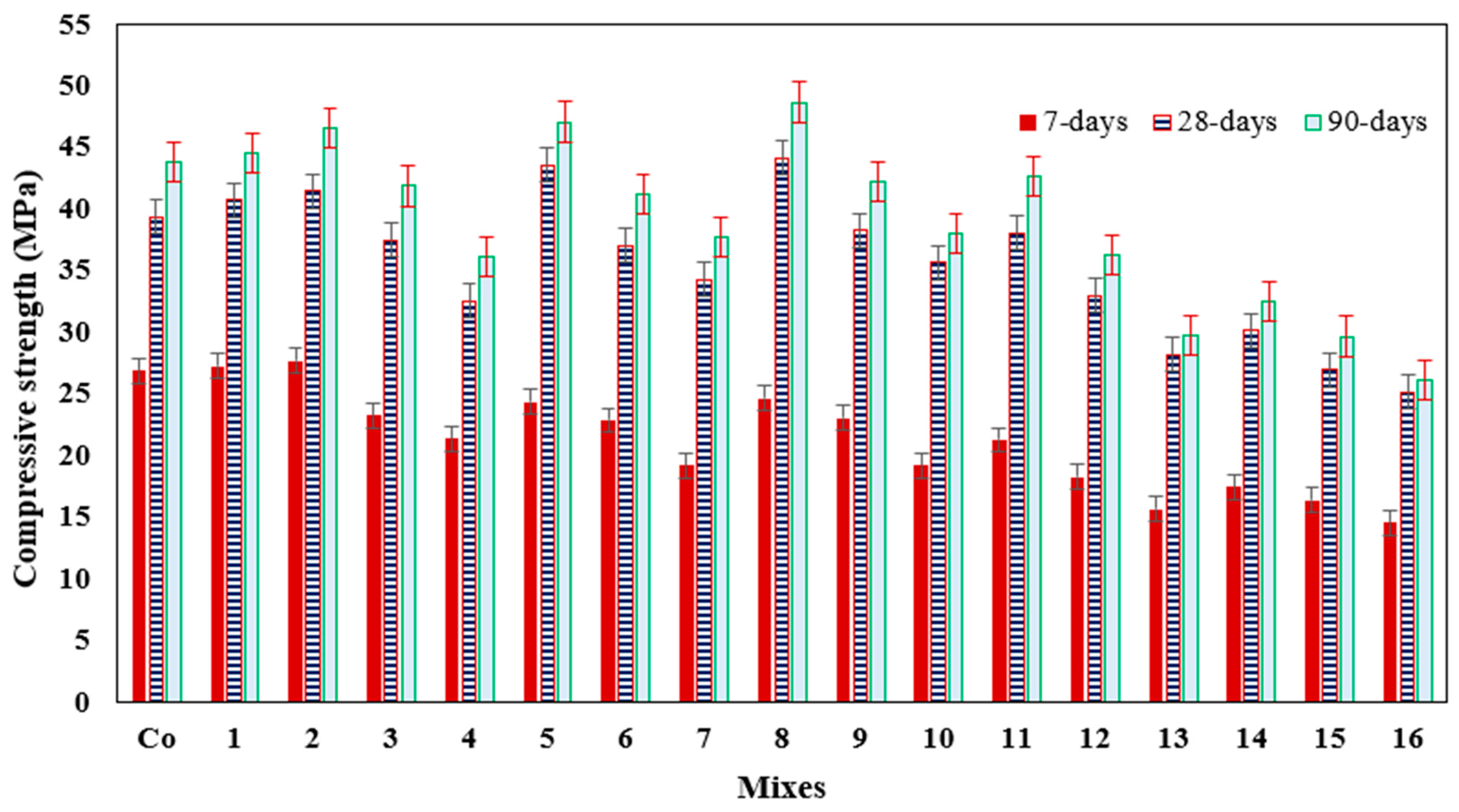



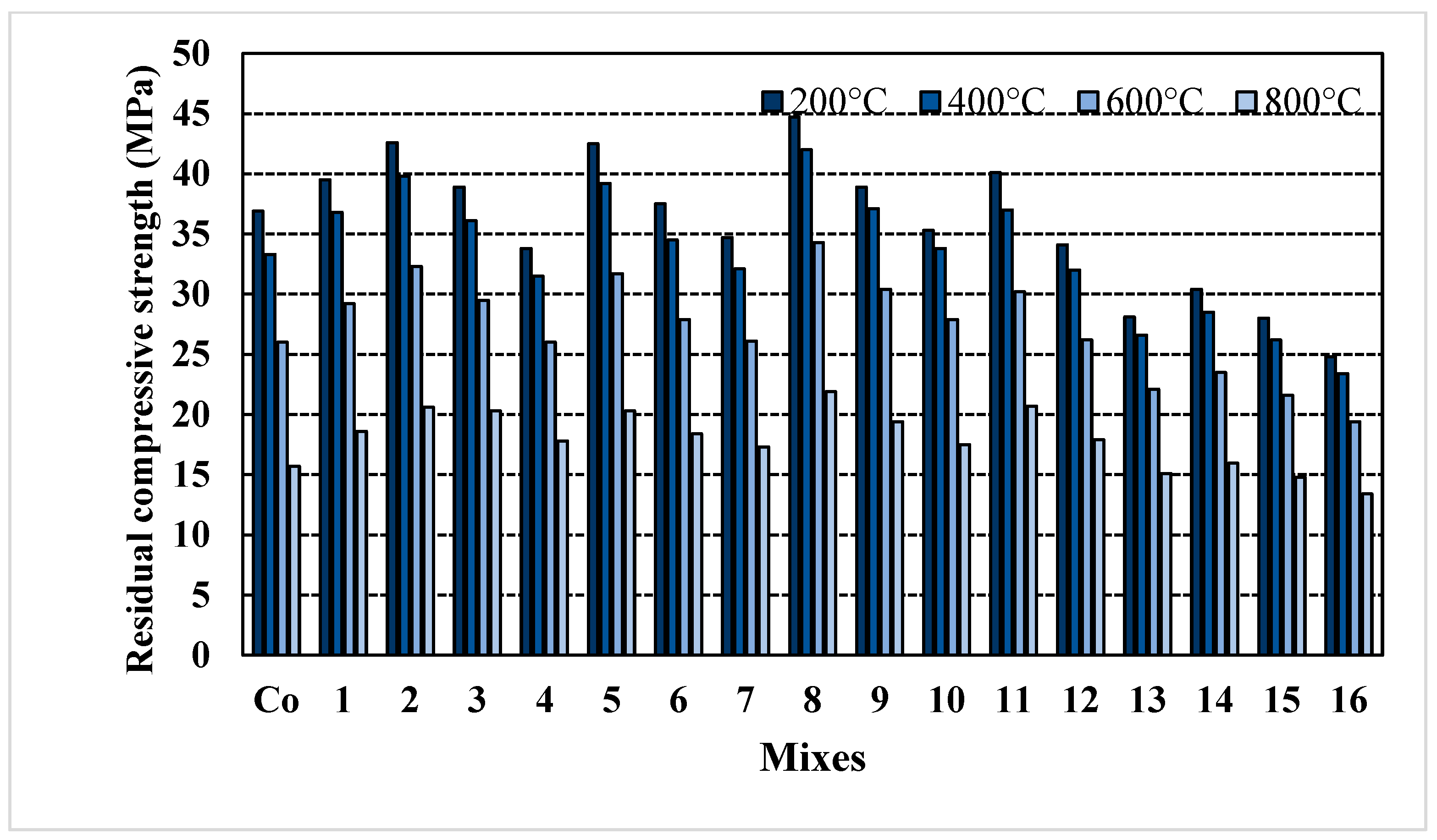
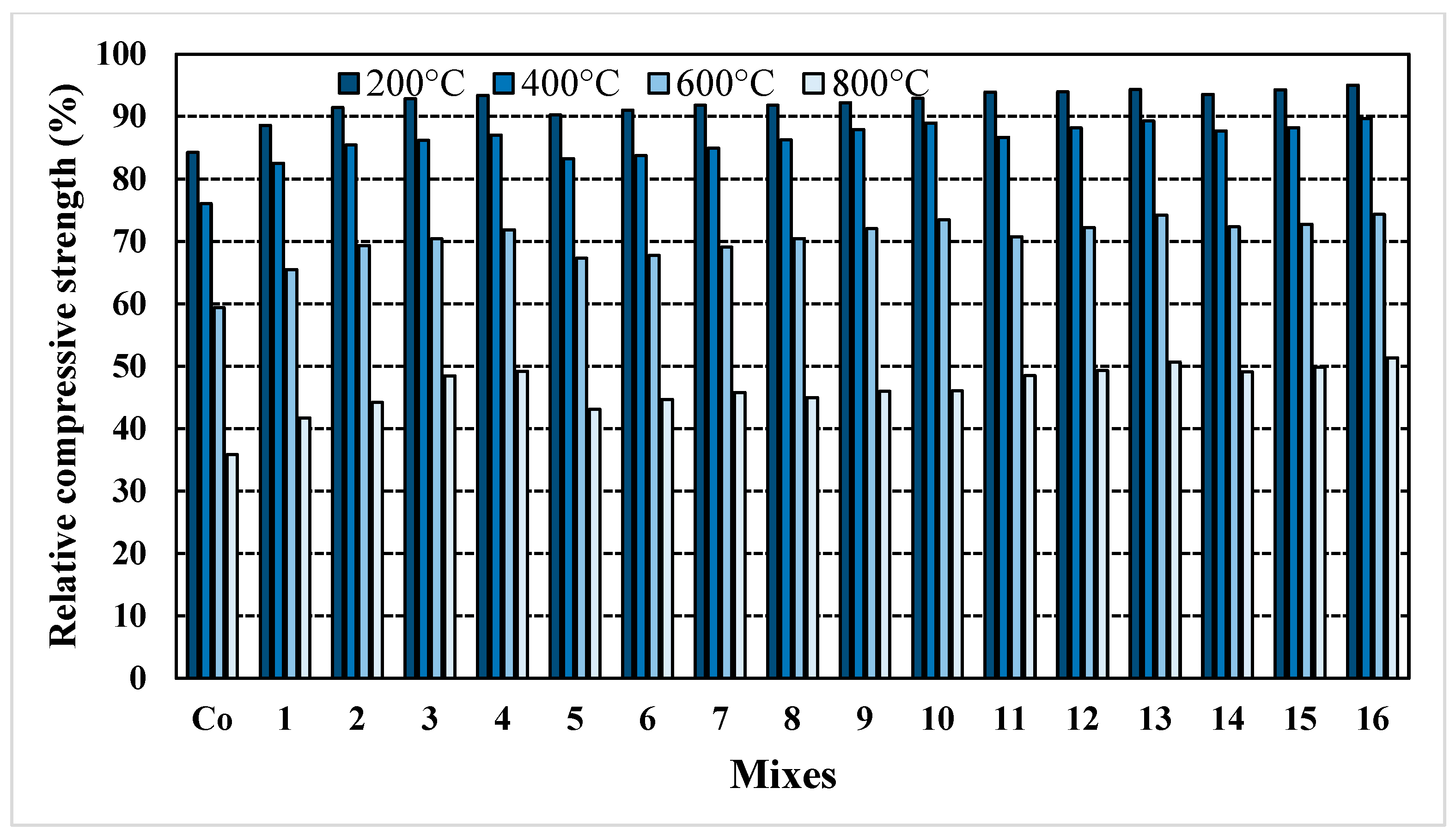

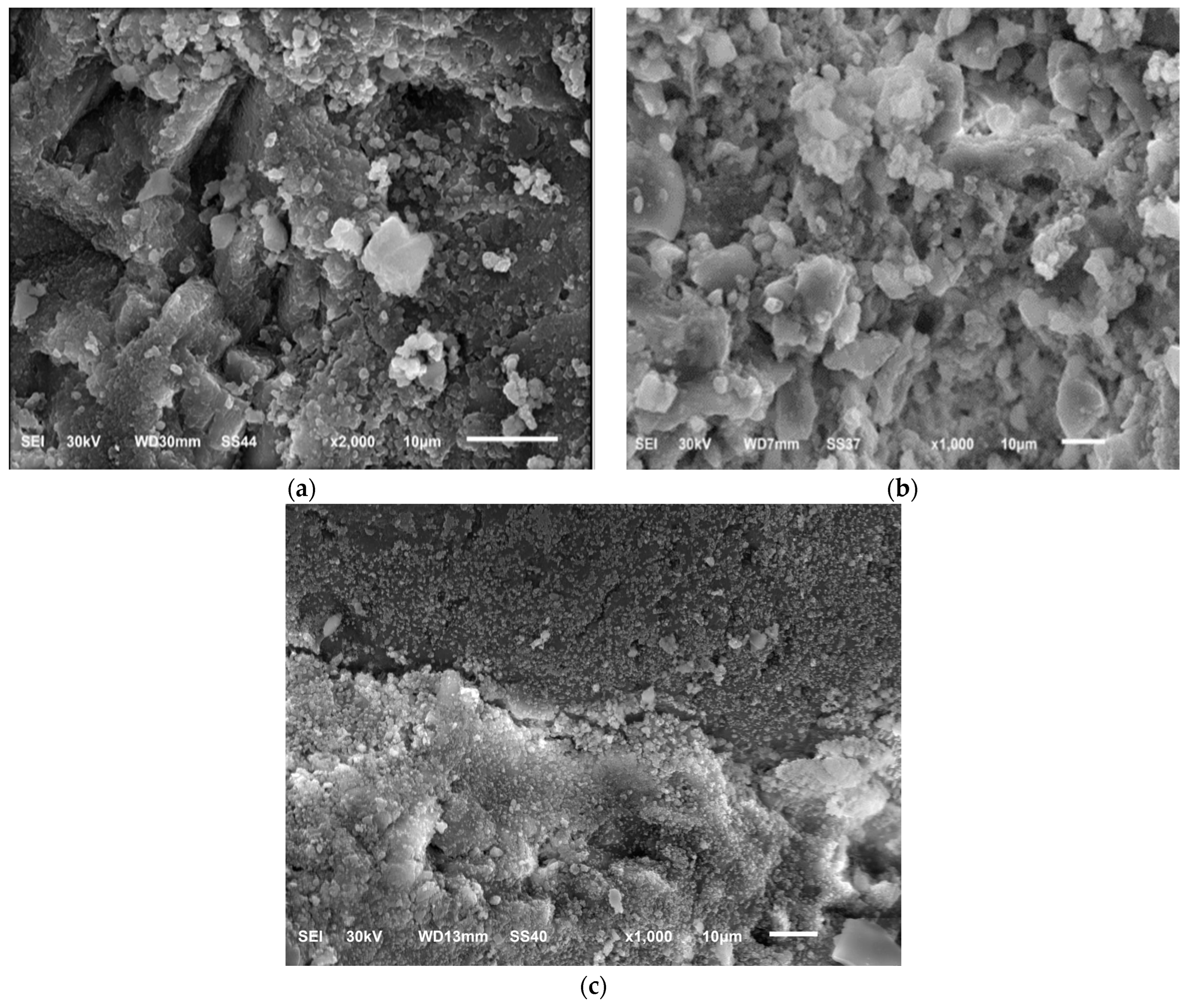

| Chemical Composition (%) | CaO | SiO2 | Al2O3 | Fe2O3 | Na2O | MgO | K2O | SO3 |
|---|---|---|---|---|---|---|---|---|
| Cement | 59.3 | 23.4 | 4.72 | 3.62 | 0.23 | 2.74 | 0.12 | 2.95 |
| CWP | 1.51 | 68.8 | 18.4 | 1.05 | 3.52 | 3.25 | 1.98 | - |
| Mix | Mixture ID | Cement | CWP | Sand | CWF | Dolomite | Water | SP |
|---|---|---|---|---|---|---|---|---|
| Co | 0%CWP + 0%CWF | 400 | 0 | 716 | 0 | 1072 | 180 | 6 |
| 1 | 0%CWP + 25%CWF | 400 | 0 | 537 | 179 | 1072 | 180 | 6 |
| 2 | 0%CWP + 50%CWF | 400 | 0 | 358 | 358 | 1072 | 180 | 6 |
| 3 | 0%CWP + 75%CWF | 400 | 0 | 179 | 537 | 1072 | 180 | 6 |
| 4 | 0%CWP + 100%CWF | 400 | 0 | 0 | 716 | 1072 | 180 | 6 |
| 5 | 10%CWP + 25%CWF | 360 | 40 | 537 | 179 | 1072 | 180 | 6 |
| 6 | 20%CWP + 25%CWF | 320 | 80 | 537 | 179 | 1072 | 180 | 6 |
| 7 | 30%CWP + 25%CWF | 280 | 120 | 537 | 179 | 1072 | 180 | 6 |
| 8 | 10%CWP + 50%CWF | 360 | 40 | 358 | 358 | 1072 | 180 | 6 |
| 9 | 20%CWP + 50%CWF | 320 | 80 | 358 | 358 | 1072 | 180 | 6 |
| 10 | 30%CWP + 50%CWF | 280 | 120 | 358 | 358 | 1072 | 180 | 6 |
| 11 | 10%CWP + 75%CWF | 360 | 40 | 179 | 537 | 1072 | 180 | 6 |
| 12 | 20%CWP + 75%CWF | 320 | 80 | 179 | 537 | 1072 | 180 | 6 |
| 13 | 30%CWP + 75%CWF | 280 | 120 | 179 | 537 | 1072 | 180 | 6 |
| 14 | 10%CWP + 100%CWF | 360 | 40 | 0 | 716 | 1072 | 180 | 6 |
| 15 | 20%CWP + 100%CWF | 320 | 80 | 0 | 716 | 1072 | 180 | 6 |
| 16 | 30%CWP + 100%CWF | 280 | 120 | 0 | 716 | 1075 | 180 | 6 |
Disclaimer/Publisher’s Note: The statements, opinions and data contained in all publications are solely those of the individual author(s) and contributor(s) and not of MDPI and/or the editor(s). MDPI and/or the editor(s) disclaim responsibility for any injury to people or property resulting from any ideas, methods, instructions or products referred to in the content. |
© 2023 by the authors. Licensee MDPI, Basel, Switzerland. This article is an open access article distributed under the terms and conditions of the Creative Commons Attribution (CC BY) license (https://creativecommons.org/licenses/by/4.0/).
Share and Cite
Elemam, W.E.; Agwa, I.S.; Tahwia, A.M. Reusing Ceramic Waste as a Fine Aggregate and Supplemental Cementitious Material in the Manufacture of Sustainable Concrete. Buildings 2023, 13, 2726. https://doi.org/10.3390/buildings13112726
Elemam WE, Agwa IS, Tahwia AM. Reusing Ceramic Waste as a Fine Aggregate and Supplemental Cementitious Material in the Manufacture of Sustainable Concrete. Buildings. 2023; 13(11):2726. https://doi.org/10.3390/buildings13112726
Chicago/Turabian StyleElemam, Walid E., Ibrahim Saad Agwa, and Ahmed M. Tahwia. 2023. "Reusing Ceramic Waste as a Fine Aggregate and Supplemental Cementitious Material in the Manufacture of Sustainable Concrete" Buildings 13, no. 11: 2726. https://doi.org/10.3390/buildings13112726






